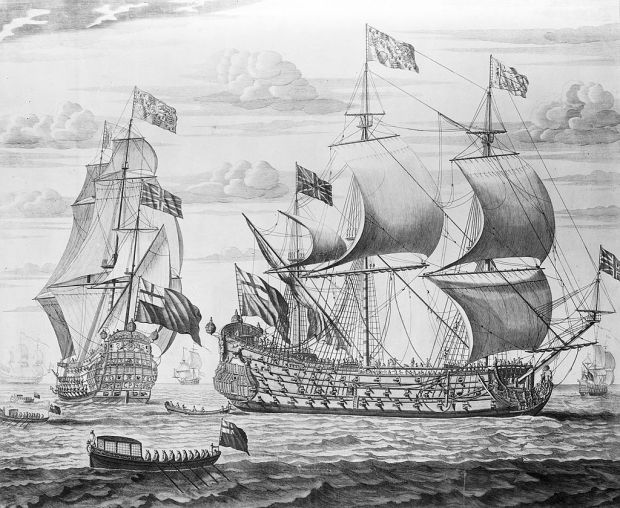
The naval Battle of Texel or Battle of Kijkduin took place on 21 August 1673 between the Dutch and the combined English and French fleets and was the last major battle of the Third Anglo-Dutch War, which was itself part of the Franco-Dutch War (1672-1678), during which Louis XIV of France invaded the Republic and sought to establish control over the Spanish Netherlands. English involvement came about because of the Treaty of Dover, secretly concluded by Charles II of England, and which was highly unpopular with the English Parliament.
The overall commanders of the English and Dutch military forces were Lord High Admiral James, Duke of York, afterwards King James II of England, and Admiral-General William III of Orange, James’ son-in-law and also a future King of England.

Neither of them took part in the fight. The Battle of Texel was joined when a Dutch fleet sought to oppose the landing of troops by a combined Anglo-French fleet.
Prince Rupert of the Rhine commanded the Allied fleet of about 92 ships and 30 fireships, taking control of the centre himself, with Jean II d’Estrées commanding the van, and Sir Edward Spragge the rear division. The Dutch fleet of 75 ships and 30 fireships was commanded by Lieutenant-Admiral-General Michiel de Ruyter, with Lieutenant-Admirals Adriaen Banckert in charge of the van and Cornelis Tromp the rear.
The Dutch were under an even greater disadvantage than the above numbers show, as Dutch warships were on the average smaller than both their English and French opponents.
De Ruyter first decided not to leave his defensive position in the Schooneveld, from which he had successfully engaged the allied fleet in the double Battle of Schooneveld. However the Dutch Spice Fleet was returning from the Indies, filled with precious cargo. With half the country under French occupation for almost a year, the Dutch Republic’s finances were in disastrous straits. The Dutch could not afford to lose the wealth the Spice Fleet was bringing, let alone allow it to be captured by the enemy. As such stadtholder William ordered De Ruyter to seek to engage the enemy.
Although outnumbered, De Ruyter gained the weather gauge and sent his van under Adriaen Banckert in to separate the Allied van (under D’Estrées) from the main fleet. His ploy was effective, and the French ships were unable to play a significant part in the remainder of the battle, which became a gruelling encounter between the bulk of the Dutch fleet and the English centre and rear divisions. Both suffered badly during hours of fierce fighting.
Spragge and Tromp, commanding their respective rear divisions, clashed repeatedly — Spragge had publicly sworn an oath in front of King Charles that this time he would either kill or capture his old enemy Tromp — each having their ships so damaged as to need to shift their flags to fresh ships three times. On the third occasion, Spragge drowned when his boat took a shot and sank.
Because of Spragge’s preoccupation with duelling Tromp, the English centre had separated from the rear, clashing with the Dutch centre under De Ruyter and Lieutenant-Admiral Aert Jansse van Nes. The fight raged for hours, due to turnings of the wind each side suddenly gaining or losing the advantage of the weather gauge. Banckert managed to disengage from the French and joined the Dutch centre, upon which Rupert decided to move north to the rear squadron to prevent that he would have to fight a superior Dutch force, followed by De Ruyter with the mass of his ships. The fight then focused on an attempt by the Dutch to capture Spragge’s isolated flagship, the Prince, which in the end failed.

With both fleets exhausted, the English eventually abandoned their attempt to land troops (the landing force known as the Blackheath Army was still waiting in England to be shipped), and both sides retired. No major ship was sunk (although several fireships were expended on each side), but many were seriously damaged and about 3,000 men died: two-thirds of them English or French. After the battle Prince Rupert complained that the French had not done their share of the fighting, but historians ascribe the lack of French impact on the battle to de Ruyter’s brilliant fleet handling. It is true however that Count d’Estrées had strict orders from Louis XIV not to endanger the French fleet, as he himself admitted after the battle. Despite its inconclusive finish, the battle was a clear strategic victory for the Dutch.
The Spice Fleet arrived safely, bringing the much needed financial reprieve. In the months following, the Netherlands formed a formal alliance with Spain and the Holy Roman Empire. The threat posed by German and Spanish invasions from the south and east forced the French to withdraw from the territory of the Republic. The Third Anglo-Dutch War came to an end with the signing of the Treaty of Westminster between the English and the Dutch in 1674. Fourteen years later the Glorious Revolution, which saw Stadtholder William III ascend the throne of England, put an end to the Anglo-Dutch conflicts of the 17th century. Only in 1781 would the Dutch and British fleets fight each other again in the battle of Dogger Bank.

I am passionate about my site and I know you all like reading my blogs. I have been doing this at no cost and will continue to do so. All I ask is for a voluntary donation of $2, however if you are not in a position to do so I can fully understand, maybe next time then. Thank you.
To donate click on the credit/debit card icon of the card you will use. If you want to donate more then $2 just add a higher number in the box left from the PayPal link. Many thanks.













You must be logged in to post a comment.